Rachel S. Cordasco's Blog, page 7
March 21, 2024
Review: Behind the Red Mist by Ho Anh Thai

translated by Nguyen Qui Duc, Regina Abrami, Bac Hoai Tran, Phan Thanh Hao, and Dana Sachs
Curbstone Press, 1998
grab a copy here or through your local independent bookstore or library
speculative stories included:
“The Goat Meat Special” (tr. Ho Anh Thai and Wayne Karlin)
“The Man Who Believed in Fairy Tales” (tr. Ho Anh Thai and Wayne Karlin)
“Behind the Red Mist” (tr. Nguyen Qui Duc and Wayne Karlin)
Ho Anh Thai’s Behind the Red Mist is a powerful collection of stories set during and after the Vietnam War, revealing much about the people and culture of that country during the mid-20th c. Of the ten stories included, just a few would be considered “speculative,” but they all offer insight into a world built on family ties, communist bureaucracy, and terror from bombs that could drop from the sky at any moment.
“The Goat Meat Special,” “The Man Who Believed in Fairy Tales,” and the novella “Behind the Red Mist” are surreal stories, verging on magical realism. In “Goat,” a man realizes that his tv displays pornographic movies only when his wife and family aren’t at home. Wondering if it will work if he invites his friend (who’s also his boss) over, Hoi is excited when it does…but then his boss turns into a literal goat. Though goats are often symbols of good fortune and fertility, in Ho An Thai’s story, the goat is a symbol of lasciviousness and promiscuity. The protagonist’s own wife, we’re told at the beginning, once again “slunk off to meet with her boss…Hoi wondered why she was sneaking in and out of the house so much these days” (36). When Dien realizes that he is a goat, he also notices that he can still speak (and even kind of looks like his old self). Hoi hides him, but his wife eventually finds out. She isn’t too surprised (surprisingly), since, as she explains to Hoi, “I saw him for the first time like this on the very day he came to ask me to marry him. My parents and siblings were all full of praise for him: he was so handsome and so talented, a General Manager and barely over 30 years old. Only I saw that coming into our house that day was a sharp bearded goat, insensitive to human beings” (41).
Unexplained transformation is also at the heart of “The Man Who Believed in Fairy Tales,” since the Vietnamese protagonist magically turns into an American after living in the US for a short time. Having gone there just for a six-week training session, he finds one morning that he suddenly has blue eyes and an aquiline nose. This change bodes ill for him, since he is supposed to meet his Vietnamese-American girlfriend’s family. They’re expecting a Vietnamese man, and when they see what he has become, they immediately refuse to let their daughter and granddaughter marry him. Arguments between the generations over marriage partners is a major theme in this collection, revealing deeply ingrained traditions and ideas of honor. When the protagonist returns to Vietnam still looking like an American, people start calling him “Mr. Westerner,” despite the fact that he speaks perfect Vietnamese and tries to explain his situation. Friends and acquaintances then use him and his Western-cultural capital to get what they want, while he’s left depressed and confused. Only at the end of the story, when he pours out his sadness to a neighborhood girl, she consoles him with the following story: “Perhaps one day a fairy would appear who honestly loved me, not because I was a Westerner or for hundreds of other reasons. Only when I met that sincere love would the curse be lifted to me, and I would return to being who I was before” (102).
The past (1960s) and its difficult relation to the present (1980s) is another major theme running throughout these stories. As Wayne Karlin explains in his introduction, Ho Anh Thai’s writing coincides with the period of Doi Moi (“Renovation”), where fiction that otherwise wouldn’t have been allowed by state-owned publishing houses could now be published and distributed:
The policy lifted centralized control and encouraged a market economy in Vietnam; one of its side effects was the permission given to writers to create literature that broke away in form and content from “socialist realism” and that was allowed to criticize the incompetence and corruption of high officials, to depict the losses of war as well as its heroism and sacrifice, to create characters who were complex mixtures of good and bad (cai xau), even if they were communist party members; to write of the personal as well as the social. (xiii)
Many of these features are central to “Behind the Red Mist,” a story about a young man (Tan) thrown back in time after getting electrocuted in 1987. When the high rise apartment building he and his parents and paternal grandmother live in partially collapses, Tan saves his grandmother and runs back to help others, accidentally stepping on a live wire. He wakes up in 1967, in the midst of war. Despite the suffering and destruction all around him, Tan witnesses his parents’ courtship, which is in direct violation of his maternal grandmother’s wishes. Meanwhile, his father is part of a team dredging up a French boat that had sunk during colonial times, with the intention of using it in defense against the American bombers. The boat here functions as a tangible reminder of the past but also as a symbol of transformation and renewal. Experiencing this war-torn past and even hearing about his own birth, Tan more clearly understands how deeply things have shifted in Vietnam since the war ended: the younger generation recoils from violence and any talk of war, wishing to move forward into a market economy, while the older generation is still holding on to traditions and communist ways of life. Tan’s time-travel allows him to act as a bridge, helping his parents find time to be together and potentially softening his maternal grandmother’s opposition.
Behind the Red Mist offers us a wonderfully expressive window onto Vietnam’s past and the ways in which its people have adapted and transformed themselves since the end of the war. Ho Anh Thai’s speculative stories, in particular, display the writer’s versatility in trying to capture the complexities of a country in the midst of change.
March 14, 2024
Review: The Cemetery of Chua Village and Other Stories by Doan Le
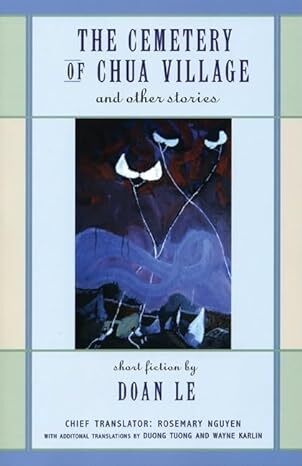
translated by Rosemary Nguyen, Duong Tuong, and Wayne Karlin
Curbstone Press, 2005
grab a copy here or through your local independent bookstore or library
speculative stories included:
“The Cemetery of Chua Village” (tr. Rosemary Nguyen)
“Achieving Flyhood” (tr. Rosemary Nguyen)
“The Venus of Chua Village” (tr. Rosemary Nguyen)
“The Clone” (tr. Duong Tuong with Wayne Karlin)
Doan Le’s The Cemetery of Chua Village and Other Stories includes ten tales, four of which are speculative in some way. Ghosts, metamorphoses, reincarnation, and cloning stand shoulder to shoulder with “realistic” stories of dissolving marriages; greedy land speculators; and tragic, lonely lives. A lovely collection of snapshots offering readers a window onto post-war Vietnam from the perspective of everyday Vietnamese people, Chua Village is an important work of early 21st c. Vietnamese literature.
The collection begins with two speculative stories, setting a slightly surreal tone that infuses the entire book. In “The Cemetery of Chua Village,” a mix-up at a morgue results in a working-class man getting put into a general’s clothes and being placed in an expensive coffin, ready for a state funeral. At once hilarious and sobering, the story is told from the point of view of one of the “ghosts” who already lives in the cemetery. Apparently, when night falls, the skeletons in all their many forms (some still with flesh, some without) open up their coffins and walk around, visiting with friends and family, gossiping, and wondering about who will join them. They know that a new grave is being dug, and when the newcomer arrives, the ghosts knock on the coffin and pepper the ghost with questions until he explains the mix-up and how his son figured out the problem at the very last minute. The narrative voice is folksy and conversational, and the reader is told about life in the cemetery as if it’s nothing out of the ordinary–as if life goes on, just in a different form. As the first sentence of the story notes, “Whether one happens to be alive or dead, it is a very good thing to find oneself surrounded by kindly neighbors” (3).
Magical realism fuels the next story, “Achieving Flyhood,” in which a circus performer trying to get a housing grant from the Ministry turns into a fly when the man reviewing his application says, “You know how it is…too little honey, and too many flies!” (33). As in “The Cemetery,” “Flyhood” strikes a humorous note at the beginning, with the narrator referencing Kafka’s “Metamorphosis,” as if preparing us for what’s to come. What follows is a tale about the former man realizing that being a fly isn’t so bad (despite being prey for a host of predators), especially since he doesn’t need to worry about housing now and the problems that his wife has been giving them since their separation. Indeed, he is found by other humans-turned-flies, who (hilariously) have formed their own complicated bureaucratic structure, complete with titles and in-fighting. The absurdity of the man-fly’s situation highlights the equally absurd human social/political structures that make their workers seem inhuman and applicants feel like they’re in a maze.
“The Venus of Chua Village” is much more subtly speculative, touching lightly on reincarnation and leaving a surreal feeling in the reader’s mind at its end. Here, a painter is approached by a man in the village who needs money to pay off a debt. He offers his sister as a nude model in exchange for payment. The sister, Huong, is not enthusiastic about posing, but knows that they need the money, while the painter finds the whole situation unnerving. Nonetheless, he paints Huong, being careful to include a large red birthmark that appears on her chest. The painting then falls into the hands of a small shopkeeper, who falls in love with a woman whose mother was…Huong. At the end, the story shifts back in time, with the painter asking Huong if she’d like to hear a story about a shopkeeper who has a certain painting….
A speculative story about cloning wraps up the collection, securing our feeling that surrealism and magical realism mark each of these stories, even those that seem most rooted in realistic depictions of life in a Vietnamese village or city. In “The Clone,” a man who ran away from home after his parents divorced and each started new families is confronted by a visitor who looks exactly like his father. Thinking that this must be a step-brother, the narrator is shocked to learn that his visitor is actually a clone of his father. The narrator allows the clone to live in his house for a bit, only to then learn that his mother also cloned herself, and that the two clones have fallen in love. Horrified, the narrator imagines another version of himself being born and going through the grief that he went through for decades. Though he tries to keep the two clones apart, he is ultimately unsuccessful.
Thanks to The Cemetery of Chua Village, Anglophone readers who don’t know much about Vietnam or Vietnamese culture can learn more about the social, political, and cultural aspects of Vietnamese country and city life. Doan Le’s sometimes playful, sometimes deadly serious narrative voices give this collection of stories dimension and endurance in 21st century literature.
March 12, 2024
Vietnamese SFT
I’ve been interested in finding some Vietnamese SFT and I finally did! See below for two collections, and please let me know if there are more!

The Cemetery of Chua Village and Other Stories by Doan Le, translated by Rosemary Nguyen, Wayne Karlin and Tuong Doung (Curbstone Books, 2005).
“This seventh volume in the “Voices from Vietnam” series introduces U. S. readers to another major figure in modern Vietnamese Doan Le. Noted for her versatility of style and her originality, she writes tales that are intensely human and universal, exploring such subjects as greed, marriage, divorce, aging and human rights. For the scholar, these stories give insight into Vietnamese culture after the “renovation”. For the general reader, these are stories that explore all the subtle enigmas of the human heart. As Wayne Karlin notes in his introduction, ‘[She] is a master of allegory and gently complex satire…her stories can often be fantastical—Sholom Aleichem’s village of Helm channeled by Kafka through Our Town— or they can be deeply personal and realistic. In both cases they grow unabashedly from the real vicissitudes of her life.'”

Behind the Red Mist by Ho Anh Thai, translated by Qui Duc Nguyen, Regina Abrami, Bac Hoai Tran, Ho Ang Thai, Wayne Karlin, Phan Thanh Ho, Dana Sachs (Curbstone Books, 1998)
“Behind the Red Mist gives us for the first time in English a wide range of stories from the most important writer of the post-war generation in Vietnam. The characters range from a party official who turns into a goat while watching porno movies, to an Indian who carries his mother’s bones in his knapsack, to a war widow trying desperately to piece together her life through the fragments of debris she collects from her back yard. The title novella “Behind the Red Mist” is a Vietnamese Back To the Future, a social satire in which a young man in the Hanoi of the eighties receives an electric shock and is transported back to his same apartment block in 1967 wartime Vietnam during the American bombing. He not only witnesses the war with the eyes of someone who knows its outcome, but participates in his parents’ courtship and discovers some truths about the generation held up to his own as a role model.”
March 6, 2024
Review: The Inhumans and Other Stories: A Selection of Bengali Science Fiction
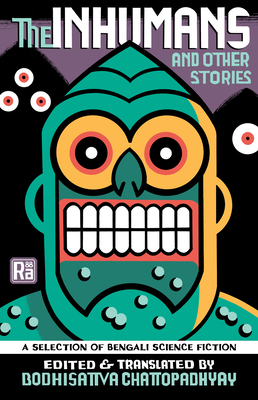
edited and translated by Bodhisattva Chattopadhyay
MIT Press (part of the Radium Age Book Series), 2024
grab a copy here or through your local independent bookstore or library
Contents:
The Inhumans (Amanushik Manush) (1935) by Hemendrakumar Roy
“Voyage to Venus” (“Shukra Bhraman”) (1895) by Jagadananda Ray
“The Mystery of the Giant” (“Danab Rahassya”) (1931) by Nanigopal Majumdar
“The Martian Purana” (“Mangal Purana”) (1931) by Manoranjan Bhattacharya
The latest in MIT Press’s Radium Age series, The Inhumans and Other Stories: A Selection of Bengali Science Fiction is part of a growing corpus of Southeast Asian sf being translated into English. This is very good news for readers interested in growing their knowledge of world sf and its various iterations and traditions. Thanks to editor and translator Bodhisattva Chattopadhyay, one of the editors of Indian Genre Fiction: Pasts and Future Histories (2018) and Kalicalypse: Subcontinental Science Fiction (2022), Anglophone readers now have access to some fascinating stories from Bengali writers of the 1930s (and even one from 1895). Explaining in his introduction that all of these stories grapple with colonial realities and tropes that were being developed in the Anglophone world (including the popular Lost World trope), Chattopadhyay introduces us to writers who found their places in the Bangla popular literature of the early 20th century.
One of the most interesting points in the introduction is Chattopadhyay’s discussion of how literary magazines in colonial Bengal were genre melting pots: “translations, puzzles, short fiction, serialized novels, news of inventions and discoveries, historical articles, stories from mythological sources, geographical pieces, political commentary,…children’s fiction, comedy, fantasy, myth-fiction, and sf could all be found here,” along with translations of Conan Doyle, Wells, Burroughs, and Verne (translated or adapted by the author of The Inhumans).
Throughout this fascinating anthology, I found myself wanting more: more historical context, more explanations, more commentary from Chattopadhyay (that introduction is excellent). I understand that this volume is supposed to be reader-friendly, and so the number of endnotes was small (also, did I ever mention that I loathe endnotes? Footnotes FTW!). Basically, what I wanted was a Ulysses-style annotated text- I wanted (yes, I’m greedy) margin notes on every page, because I am woefully ignorant of Bengali culture. But it’s precisely anthologies like this that make me want to learn more (and also cry because even if I lived to 800, I wouldn’t have time to learn all the things I want to learn! But I digress…).
To the stories: be prepared to find yourself thinking “wait, what just happened?” at least three times in every tale, because wow, some very strange things are happening. In the title story, which is divided into two parts, a Bengali man travels to Africa for a hunting expedition. Included in the tale is an extended extract from the real book Kill or Be Killed: The Rambling Reminiscences of an Amateur Hunter (1933) by W. Robert Foran, describing the gorgeous and dangerous African landscape and its wildlife. When the narrator goes hunting gorillas in the jungle, he encounters the “Valakhilyas,” the smallest people on the planet. They act as guides, but then grow fearful when the camp gets raided multiple times by an unknown (possibly not human?) entity. The narrator becomes obsessed with figuring out the mystery.
The second part of the narrative, set in Uganda, focuses on the “Juju Mountain,” said to be inhabited by some sort of malevolent force. As in the first part, here what is said to be supernatural by the native people turns out to be something…not mundane, but definitely not supernatural. I’ll just say it involves a very hungry lion. The narrator then finds a diary, left by another Bengali hunter years before, and the rest of the narrative is quoted from that diary, involving a bizarre species of human that has evolved to no longer need a skeletal structure.
(spoiler alert) “Voyage to Venus” was especially interesting reading for me because, just a over a month ago, I read another short narrative, written in the late 19th century, that used the “sleeper awakes” literary device: Czech author Jakub Arbes’s Newton’s Brain (1877). Both “Voyage” and Newton involve young friends interested in the burgeoning scientific field who together explore what, in real life, seems fantastic. In “Voyage,” the friends are hanging out and talking about a book by an English astronomer about the planets–Venus in particular–when the narrator closes his eyes and drifts off. Imagine his surprise when he wakes up…on the dark side of Venus. He eventually meets up with his friend, who has discovered a race of Venusians (the narrator calls them “primitive” and “uncivilized,” in keeping with the Lost World trope) that evolved to live simply but contentedly on the small planet. But then the narrator and his friend encounter an “advanced race” of Venusians living on the other side of that world. These people, despite their technological sophistication, are baffled by the narrator’s claim that he and his friend come from another world. It’s while the narrator is on an advanced Venusian ship (for sailing, not space travel) that his friend voices a wish to return to Earth…and the narrator wakes up back on Earth.
In “The Mystery of the Giant,” Nanigopal Majumdar uses the literary device of the “strange potion” to explore the limits of human evolution. A neighborhood is convulsed by strange sightings and sounds after a man and his scientific-minded friend mysteriously disappear. As we later learn, in a letter Manu writes to his father, his friend wished to make himself into a large, strapping man to match up with his massive intellect. Of course, the potion had unintended consequences (think Dr. Jekyll and Mr. Hyde). There are also elements of Frankenstein here, especially when the giant keeps insisting that he and other humans are “brothers.”
The final story returns the reader to the Lost World narrative, with humans encountering Martians, all thanks to one woman’s love for precious gems. As Chattopadhyay explains in his intro about “The Martian Purana,” the story involves “advanced aliens coexisting in the same space as mythological characters.” “A ‘purana,'” he notes, “is a tale that takes place outside of time, yet here the past merges with the present.” It is especially with this story that I wanted some seriously long and involved margin notes, because I have this feeling that if I knew anything about Bengali folklore and myth, I would have found this story absolutely hilarious. Unfortunately, I could only really connect with the fact that a husband really wanted to make his wife happy, so he went to the underworld (you read that right) to get a famous gem. (Reader, my husband’s idea of making me happy is going to the grocery store and buying me a container of chocolate candy…and he’s not wrong). But of course, then the underworld wouldn’t have any light, so he had to go elsewhere- like Mars, where the gem was taken by a scientist, and where apparently a very advanced race lives that makes humanity seem puny. So, as one does, the husband goes to a mythological figure (Hanuman) who bounces to Mars to get the gem. He then discovers that the humans who went to Mars have been captured by the Martians and put into a zoo of strange creatures. Hanuman rescues them and returns to Earth.
Finally, I very much appreciated Chattopadhyay’s “Note on the Translation,” in which he explained that the original Bangla title could mean both “inhuman” and “human as individual but also humanity,” though he ultimately settled on The Inhumans to “encourage readers to perceive such characters as the feral child, the beings in the advanced civilization, and even the narrators as different sorts of inhumans” (xxii-xxiii). The Inhumans anthology is indeed an important new addition to the world of SFT and I look forward to reading more Bengali SFT in the future.
March 2, 2024
Out This Month: March
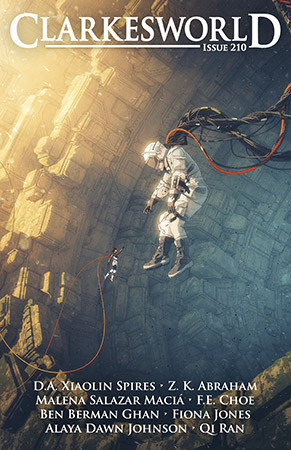 “One Flew Over the Songhua River” by Qi Ran, translated from the Chinese by Andy Dudak (Clarkesworld, March 1)
“One Flew Over the Songhua River” by Qi Ran, translated from the Chinese by Andy Dudak (Clarkesworld, March 1) Through the Night Like a Snake: Latin American Horror Stories, ed. Two Lines Press, various translators (Two Lines Press, March 12)
Through the Night Like a Snake: Latin American Horror Stories, ed. Two Lines Press, various translators (Two Lines Press, March 12)In ten chilling stories from this ensemble cast of contemporary Latin American writers, horror infiltrates the unexpected, taboo regions of the present-day psyche. Latin American Horror is having a moment. Through the Night Like a Snake, the latest in our Calico Series, is an attempt to capture that energy, however eerie or plain terrifying it appears on the page. With writings from celebrated horror practitioners like Mariana Enriquez (Our Share of Night), Mónica Ojeda (Jawbone), Camila Sosa Villada (Bad Girls) and many others, TTNLAS arrives in pitch-perfect English translation, courtesy of translators Sarah Booker, Megan McDowell, Ellen Jones, Kit Maude, Julia Sanches, and others.
 The Inhumans and Other Stories: A Selection of Bengali Science Fiction, ed. Bodhisattva Chattopadhyay, translated from the Bengali by Bodhisattva Chattopadhyay (MIT Press, March 12)
The Inhumans and Other Stories: A Selection of Bengali Science Fiction, ed. Bodhisattva Chattopadhyay, translated from the Bengali by Bodhisattva Chattopadhyay (MIT Press, March 12)The first English translation of a cult science fiction favorite by Hemendra Kumar Roy, one of the giants of early Bangla literature, and other sf stories from the colonial period in India. Kalpavigyan—science fiction written to excite Bengali speakers about science, as well as to persuade them to evolve beyond the limitations of religion, caste, and class—became popular in the early years of the twentieth century. Translated into English for the first time, in this collection you’ll discover The Inhumans (1935), Hemendrakumar Roy’s satirical novella about a lost race of Bengali supermen in Uganda. Also included are Jagadananda Ray’s “Voyage to Venus” (1895), Nanigopal Majumdar’s “The Mystery of the Giant” (1931), and Manoranjan Bhattacharya’s “The Martian Purana” (1931).
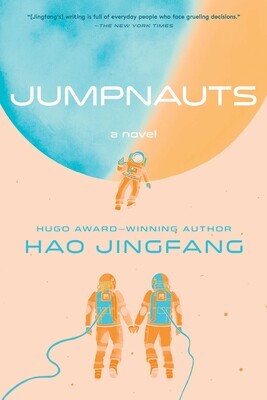
Jumpnauts by Hao Jingfang, translated from the Chinese by Ken Liu (S&S/Saga Press, March 12)
From the Hugo Award–winning author of Folding Beijing comes a gripping science fiction thriller in which three unlikely allies attempt a desperate mission of first contact with a mysterious alien race before more militaristic minds can take matters into their own hands.
February 27, 2024
Review: Your Utopia by Bora Chung

translated by Anton Hur
original publication (in Korean): 2021
this edition: Honford Star, 2024
grab a copy here or through your local independent bookstore or library
“The Center for Immortality Research”
“The End of the Voyage”
“A Very Ordinary Marriage”
“Maria, Gratia Plena”
“Your Utopia”
“A Song for Sleep” [read here]
“Seed”
“To Meet Her”
Anyone paying attention to SF in translation over the past decade would notice a welcome explosion of Korean speculative fiction in English. Of the 21 works of Korean SFT published since Cho Se-Hui’s The Dwarf in 2006 (the first in English that I’m aware of), half have come to us just in the past 3 years. Since 2021, Choi Jin-young, Bora Chung, Djuna, Kim Bo-young, Kim Un-su, Choi Jeong-Hwa, and Pyun Hye-young have brought us a diverse array of surrealism, science fiction, and the fantastic. Thanks to Anton Hur’s beautiful translations, in particular, Anglophone readers have had access to some of the most interesting Korean science fiction being written today.
Hur’s latest translation is Bora Chung’s science fiction collection Your Utopia, which follow’s Chung’s acclaimed previous collection Cursed Bunny (winner of a PEN/Heim Grant and shortlisted for the 2022 Booker International Prize). One gets the sense in this latest group of stories that Chung is quite comfortable in this subgenre of speculative fiction, confidently exploring everything from artificial and ecological intelligence to zombies in space. An immortality research center, an abandoned Mars base, a high-rise hi-tech apartment building–such spaces allow Chung to work out ethical and moral questions about human-AI (and even AI-AI) interactions and how different kinds of life fight for their right to exist.
Chung’s wry humor comes through in the very first story, as a low-level employee (just an employee? wink wink) in an immortality research center is tasked with a major project and then finds herself an accomplice to a DVD thief. The wry humor quickly becomes black humor in “The End of the Voyage,” after a mysterious disease breaks out all over the world: without warning, people just start…chomping on one another. Chung dispenses with the bloody, drooling, arm-waving zombie lurch here; she makes the zombie trope much more sinister, since no one knows who is affected. The narrator is part of a group of scientists and government officials who escape into a spacecraft and attempt to find a cure that they can bring back to Earth. The Disease follows them, though, but Chung carefully controls what we know and don’t know, resulting in a creepy ending. This story reminded me of Keren Landsman’s “Schrödinger’s Gorgon” (tr. Emanuel Lottem): a sci-fi thriller set on a spaceship about an alien virus that is transmitted through sight.
My favorite stories of the collection, though, have to be “Your Utopia,” “A Song for Sleep,” and “Seed” (which I suspect will be many other readers’ favorites). The first two feature AI protagonists that exhibit the very human emotions of regret, fear, desire, and even love. One gets the sense that Chung isn’t trying to show us that future AI will be able to achieve this, but rather that the interface of robot existence and human feeling will produce a new landscape of ethical and moral questions. In the title story, a lonely rover-like car roams the Martian landscape with a robot companion in its back seat, searching for a place to recharge itself after the human colonists have abandoned the base. Its encounters with a menacing Monster made up of discarded machines is reminiscent of Stanislaw Lem’s The Invincible (tr. N. Katherine Hayles), where abandoned technology begins to form its own kind of collective consciousness. The car’s worries about its own continued existence and the fate of its backseat companion make it a very human kind of character.
A similar attentiveness to the ill or endangered characterizes the elevator in “A Song for Sleep.” When an old, lonely woman begins to ride this intelligent elevator, the machine (as it does with all of the residents) looks into her history and preferences, attempting to accommodate itself to its occupant. When it finds that almost no information is available, the elevator becomes curious, developing an obsession with finding out what the woman likes and then trying to make her happy by playing a favorite song. The elevator witnesses the woman’s physical decline and grows to care for her, so much so that when she dies, the machine must process feelings that it was not designed to deal with.
Chung’s exploration of biotechnology’s negative impact on the natural world in “Seed” asks readers to think more deeply about what it means for corporations to control ever more land and resources. Set in an unspecified time in the future, “Seed” imagines what might happen when those tiny granules of life evolve to sprout in and on humans, turning them into human-plant hybrids.
Ultimately, what makes Your Utopia so enjoyable is its unexpectedness- the reader never knows what kind of story will come next. Chung’s vibrant imagination and Hur’s excellent translations make this collection a fantastic choice for readers.
February 14, 2024
An SFT Con
If I had all the time, energy, and money, I’d put on an ongoing SFT con the likes of which you’ve never seen. People would come from all over the world (and the universe, if the aliens were interested), just to talk SFT. So until someone else steps up to do this or when my kids go to college (whichever comes first), here’s what my SFT con might look like.
*note: I’ve never EVER organized a conference before, so this may sound completely unrealizable, and that’s fine, because, remember, it’s imaginary.

SFT Panel at WisCon 43 (2019). From left: Arrate Hidalgo, Kristy Eagar, yours truly, and Adrian Demopulous.
Photo: Keren Omry
*
NO FRILLS
First of all, this would not be a fancy con, since I’m not a fancy person. I wear sensible shoes and no makeup and I’m pretty boring, so this con would be in an unassuming, affordable hotel or a university building near an unassuming, affordable hotel. It would last for two days, because longer than that would be too long. It would just be a group of people coming together to talk about how much they love SFT. Also, I spent too long in grad school so any fancy academic language will be politely shown the door. We’re just going to talk about the stories and why we love or don’t love them and then go out for coffee and tea and talk some more.
Ok, there’ll be one fancy thing: translation headsets. Everyone will get one and will be able to speak in their own language, with anyone listening able to understand what they’re saying in their own language. Don’t ask me how we’ll pay for this, because I have no idea.
*
THE PANELS
Panels must be awesome. Here are a few examples:
“Best SFT Anthologies of the Past 10 Years”
“A Day in the Life of a Korean-to-English SFT Translator”
“What’s Going on in Bulgarian Speculative Fiction and What’s Being Translated into English?”
“Middle Eastern SFT since 2003: Dystopia and Fantasy”
“Why is There So Little Horror in Chinese, Hebrew, and Polish SFT?”
“Paying and Recognizing Translators”
“Working with Publishers and Editors”
“Dragging SF Awards into the 21st Century”
*
AWARDS
We’d have juried awards for Best Novel, Best Collection, Best Anthology, Best Short Story, Best Writer, and Best Translator. The award itself would be a very large chocolate bar or other treat of choice. And the adulation of SFT fans.
*
FREE STUFF
Available at tables throughout the con would be piles of SFT catalogs, free SFT books, and printouts of reviews. Any and all art would also be welcome- artists could sell their stuff on both days (I’ll crochet).
*
Doesn’t this sound like so much fun?! I know, I know, it would be great. Add your ideas for more fun stuff in the comments.
February 7, 2024
SFT from Quebec

Check out this special feature in the latest issue of Words Without Borders on SFFQ (la science-fiction et le fantastique québécois)!
“Thriving on Indiscipline: An Introduction to Quebec’s Science Fiction and Fantasy Scene” by Hannah Allen-Shim“Specimen” by Joyce Baker, translated by E. S. Taillon“Chlorosis” by Ariane Gélinas, translated by Remy Attig“Ruins” by Mélodie Joseph, translated by Eli Tareq El Bechelany-Lynch“Welcome, Alyson” by J. D. Kurtness, translated by Hannah Allen-Shim“Resurgence” by Ayavi Lake, translated by H. Felix Chau BradleyFebruary 3, 2024
Out This Month: February
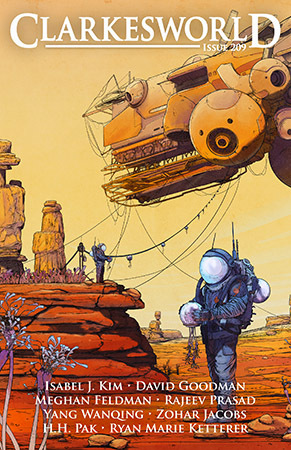 “The Peregrine Falcon Flies West” by Yang Wanqing, tr from the Chinese by Jay Zhang (Clarkesworld, February)
“The Peregrine Falcon Flies West” by Yang Wanqing, tr from the Chinese by Jay Zhang (Clarkesworld, February) You Glow in the Dark
by Liliana Colanzi, translated from the Spanish by Chris Andrews (New Directions, February 6)
You Glow in the Dark
by Liliana Colanzi, translated from the Spanish by Chris Andrews (New Directions, February 6)The seven stories of You Glow in the Dark unfold in a Latin America wrecked and poisoned by human greed, and yet Colanzi’s writing—at once sleek and dense, otherworldly and intensely specific—casts an eerily bright spell over the wreckage. Some stories seem to be set in a near future; all are superbly executed and yet hard to pin down; they often leave the reader wondering: Was that realistic or fantastic? Colanzi draws power from Andean cyberpunk just as much as from classic horror writers, and this daring is matched by her energizing simultaneous use of multiplicity and fragmentation—the book’s stylistic trademarks.
 Blue Lard by Vladimir Sorokin, translated from the Russian by Max Lawton (NYRB Classics, February 27)
Blue Lard by Vladimir Sorokin, translated from the Russian by Max Lawton (NYRB Classics, February 27)The book begins in a futuristic laboratory where genetic scientists speak in a Joycean dialect of Russian mixed with Chinese—peppered with ample neologisms—and work to clone famous Russian writers, who are then made to produce texts in the style of their forebears. The goal of this “script-process” is not the texts themselves, but the blue lard that collects in the small of their backs as they write. This substance is to be used to power reactors on the moon—that is, until a sect of devout nationalists breaks in to steal the blue lard, planning to send it back in time to an alternate version of the Soviet Union, one that exists on the margins of a Europe conquered by a long-haired Hitler with the ability to shoot electricity from his hands. What will come of this blue lard? Who will finally make use of its mysterious powers?
January 24, 2024
Review: Newton’s Brain by Jakub Arbes

translated by David Short
original publication (in Czech): 1877
first English edition: Jantar Publishing, 2023
grab a copy here or through your local independent bookstore or library
* spoilers ahead
Eighteen years before H. G. Wells published his groundbreaking science fiction novella The Time Machine, Czech author, editor, and journalist Jakub Arbes published Newton’s Brain, a surrealistic, hallucinatory science fiction story (or “romanetto”) about perception, brain transplantation, and time travel. Narrated by an unnamed man, Newton’s Brain chronicles the short life, apparent death, and bizarre reappearance (maybe?) of this man’s friend, Bedřich Wünscher–a magician, scientist, and army officer who dies at the Battle of Königgrätz during the Austro-Prussian War (1866). After narrating some of the magic tricks that his friend liked to play on people when they were schoolboys and explaining the depths of his friend’s intellectual gifts, the narrator tells of how his friend was killed in battle. Indeed, the narrator is contacted to confirm that the dying soldier is, in fact, his friend Bedřich. After seeing his friend with his own eyes, the narrator returns to his apartment, remembering that Bedřich had once told him to gather friends together and drink to him if he should die. Though the narrator tries to get this party together, no one else comes.
One night, however, the narrator hears a carriage pull up and his dead friend appears, inviting him to a banquet at the nearby chateau. Left alone, the narrator is unsure about what just happened, but seeing that, in fact, the lights are on at the chateau, he walks over to the party. Weirdly, the closer he gets to the building, the dimmer the lights, the lower the chatter and music, and the more abandoned it looks. By the time he’s inside, the place looks empty and he then spends hours trapped in an Escher-like series of hallways until he’s exhausted. Suddenly, a door opens to reveal a banquet hall filled with the top intellectuals, politicians, and theologians of the area.
What follows is a series of shocking incidents. First, a coffin appears in front of the guests, containing the very dead body of Bedřich. Next, Bedřich reanimates and sits up, climbing out of the coffin and addressing his guests eloquently on the subject of time and the ability to travel through it by flying faster than the speed of light away from the Earth. As scholar Peter Zusi writes in his introduction to Newton’s Brain, Arbes was likely influenced in this idea by a pamphlet, published in 1846 by Felix Eberty, called The Stars and the Earth; Or, Thoughts Upon Space, Time, and Eternity. This small but sensation-causing pamphlet may have also influenced Kafka and Einstein. Starting with the knowledge that light from the stars comes to Earth after different periods of time (light from the sun takes eight minutes to reach the Earth, etc.), Eberty imagines that if a human were to travel faster than light to certain points away from the planet and then look back with an unimaginably strong telescope, that human would be able to look at past events on his home planet: “With this supposition, and with the aid of a knowledge of the position and distance of every give fixed star […] it will be possible to recal [sic] sensibly to our very eyes, an actual and true representation of every moment of history that has passed” (Eberty, 35-6).
Bedřich then asks for a volunteer to help him prove this idea. Oh, and he was able not only to build upon this thought but construct the necessary materials because he stole Newton’s brain and replaced his own with it. Armed with some very strong goggles and a strange, levitating triangle structure, Bedřich calls for someone to accompany him, and the narrator accepts. Their strange journey through space and time is filled with battle after battle, war after war, demonstrating that conflict marks every period in human history. The triangle ship then hits a snag and the two are tossed around, whereupon the narrator wakes up in his apartment, unsure if any of the night’s events happened at all.
An important, surrealistic work of early science fiction, Newton’s Brain explores the nature of consciousness and perception, whether or not thoughts can be transferred if a brain is moved from one body to another, and how humans might conquer time and space to learn about their past. Thanks to translator David Short and Jantar Publishing, Anglophone readers can now enjoy this fascinating work of Czech science fiction.



